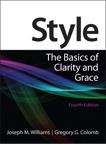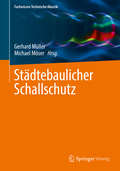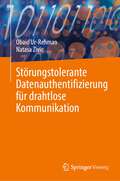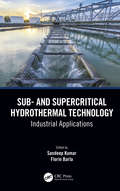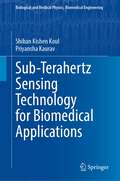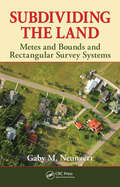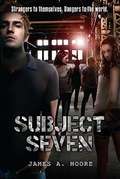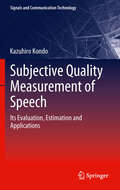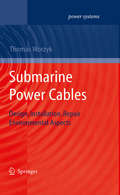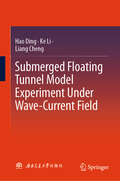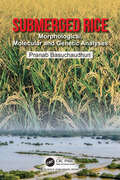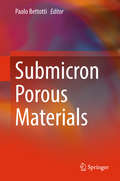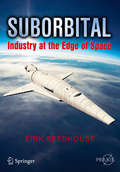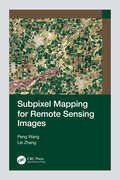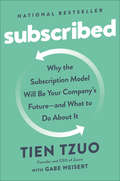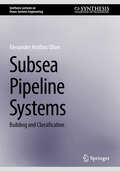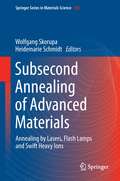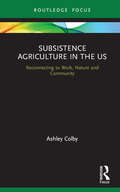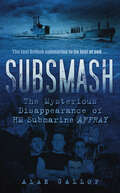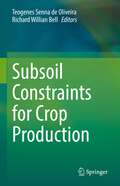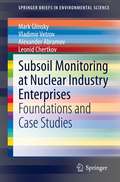- Table View
- List View
Style: The Basics of Clarity and Grace
by Joseph Bizup Joseph WilliamsStyle: The Basics of Clarity and Grace reflects the wisdom and clear authorial voice of Williams' best-selling book, Style: Lessons in Clarity and Grace, while streamlining every chapter to create a very brief, yet powerfully direct guide to writing with style. The concise clarity of this book makes it a handy reference for anyone interested in good writing--as well as a quick and ideal guide for freshman composition courses, writing courses across the disciplines, and as a supporting text in courses that require clear and direct writing. Style: The Basics covers the elemental principles of writing that will help students diagnose the strengths and weaknesses of their prose quickly and revise effectively. The text features principles of effective prose written in Williams' hallmark conversational style, offering reason-based principles, rather than hard and fast rules, for successful, effective writing.
Style: The Basics of Clarity and Grace (4th Edition)
by Joseph M. Williams Gregory G. ColombStyle: The Basics of Clarity and Grace reflects the wisdom and clear authorial voice of Williams' best-selling book, Style: Lessons in Clarity and Grace, while streamlining every chapter to create a very brief, yet powerfully direct guide to writing with style. The concise clarity of this book makes it a handy reference for anyone interested in good writing.
Städtebaulicher Schallschutz (Fachwissen Technische Akustik)
by Michael Möser Gerhard MüllerIn diesem Band der Reihe Fachwissen Technische Akustik werden die Beeinträchtigungen durch Umgebungslärm dargestellt und aus den Lärmwirkungen Zielwerte für den Lärmschutz abgeleitet. Die Methodik des städtebaulichen Lärmschutzes wird erläutert. Das aktuell gültige Immissionsschutzrecht wird beschrieben und bewertet. Für den Straßenverkehrslärm als relevanteste Quelle werden Instrumente und Maßnahmen zur Minderung vorgestellt.
Störungstolerante Datenauthentifizierung für drahtlose Kommunikation
by Obaid Ur-Rehman Natasa ZivicDieses Buch gibt einen Einblick in die Herausforderungen der Datenauthentifizierung über drahtlose Kommunikationskanäle. Die Autoren gehen davon aus, dass die etablierten Standard-Authentifizierungsmechanismen nicht ausreichen, um Daten wie Sprache, Bilder und Videos über drahtlose Kanäle zu authentifizieren, da die drahtlose Kommunikation durch zahlreiche Störungen gekennzeichnet ist. Die Autoren schlagen neue Mechanismen vor, die auf so genannten Soft-Authentifizierungsalgorithmen basieren, die einige Änderungen an den zu schützenden Daten tolerieren. Die Autoren erklären, dass das Ziel dieser Algorithmen darin besteht, tolerant gegenüber inhaltlichen Änderungen auf Grund von Übertragungsfehler zu sein, aber dennoch in der Lage zu sein, Fälschungen zu erkennen. Ein weiterer Vorteil der Soft-Authentifizierungsalgorithmen besteht darin, dass sie in der Lage sind, die veränderten Stellen zu identifizieren und sie nach Möglichkeit zu korrigieren. Die Autoren zeigen, wie man dies erreicht, indem man die Datenmerkmale mit Hilfe von fehlerkorrigierenden Codes schützt. · Erörtert Methoden zur Authentifizierung von Daten (insbesondere von Bildern) bei Übertragungsstörungen, die bei der drahtlosen Kommunikation auftreten; · Stellt eine neue Klasse von Soft-Authentifizierungsmethoden vor, die anstelle der üblichen Hard-Authentifizierungsmethoden verwendet werden, um geringfügige Änderungen der Bilddaten zu tolerieren; · Verfügt über Authentifizierungsmethoden, die auf der Verwendung von Authentifizierungscodes und digitalen Wasserzeichen basieren
Sub- and Supercritical Hydrothermal Technology: Industrial Applications
by Sandeep Kumar Florin BarlaSub- and Supercritical Hydrothermal Technology: Industrial Applications offers a practical view of a variety of industrial applications and their challenges, offering a deep understanding of the application of sub- and supercritical fluids and their techno-economic viability. This book covers a wide range of applications of hydrothermal processing that result in almost zero waste, high energy efficiency, sustainable chemical processes, and minimal impact over the life cycle. These applications include processing of hazardous waste, bioproducts, coal, lipids, heavy oil and bitumen, and carbon materials. The use of hot-compressed water instead of different organic solvents, such as methanol, acetone, and hexane, is an environmentally benign, green, and sustainable option which can help to design chemical processes that support green chemistry and engineering. This book is pertinent for researchers and professionals in the fields of chemical engineering, industrial chemistry, environmental engineering, materials engineering, and manufacturing.
Sub-Micron Semiconductor Devices: Design and Applications
by Ashish RamanThis comprehensive reference text discusses novel semiconductor devices, including nanostructure field-effect transistors, photodiodes, high electron mobility transistors, and oxide-based devices. The text covers submicron semiconductor devices, device modeling, novel materials for devices, novel semiconductor devices, optimization techniques, and their application in detail. It covers such important topics as negative capacitance devices, surface-plasmon resonance devices, Fermi-level pinning, external stimuli-based optimization techniques, optoelectronic devices, and architecture-based optimization techniques. The book: Covers novel semiconductor devices with submicron dimensions Discusses comprehensive device optimization techniques Examines conceptualization and modeling of semiconductor devices Covers circuit and sensor-based application of the novel devices Discusses novel materials for next-generation devices This text will be useful for graduate students and professionals in fields including electrical engineering, electronics and communication engineering, materials science, and nanoscience.
Sub-Terahertz Sensing Technology for Biomedical Applications (Biological and Medical Physics, Biomedical Engineering)
by Shiban Kishen Koul Priyansha KauravThis book offers the readers an opportunity to acquire the concepts of artificial intelligence (AI) enabled sub-THz systems for novel applications in the biomedical field. The readers will also be inspired to contextualize these applications for solving real life problems such as non-invasive glucose monitoring systems, cancer detection and dental imaging. The introductory section of this book focuses on existing technologies for radio frequency and infrared sensing in biomedical applications, and their limited use in sensing applications, as well as the advantages of using THz technology in this context. This is followed by a detailed comparative analysis of THz electronics technology and other conventional electro optic THz setups highlighting the superior efficiency, affordability and portability of electronics-based THz systems. The book also discusses electronic sub-THz measurement systems for different biomedical applications. The chapters elucidate two major applications where sub-THz provides an edge over existing state of the art techniques used for non-invasive measurement of blood glucose levels and intraoperative assessment of tumor margins. There is a detailed articulation of an application of leveraging machine learning for measurement systems for non-invasive glucose concentration measurement. This helps the reader relate to the output in a more user-friendly format and understand the possible use cases in a more lucid manner. The book is intended to help the reader learn how to build tissue phantoms and characterize them at sub-THz frequencies in order to test the measurement systems. Towards the end of the book, a brief introduction to system automation for biomedical imaging is provided as well for quick analysis of the data. The book will empower the reader to understand and appreciate the immense possibilities of using electronic THz systems in the biomedical field, creating gateways for fueling further research in this area.
Subdividing the Land: Metes and Bounds and Rectangular Survey Systems
by Gaby M. NeunzertIdeally, every tract of land has a description on paper and a physical survey on the ground. When boundary disputes arise, all parties concerned must quickly learn the vocabulary and processes involved with real estate. Written for anyone dealing in real estate transactions, Subdividing the Land: Metes and Bounds and Rectangular Survey Systems prov
Subject Seven
by Moore James A.Years ago, scientists began developing the ultimate military weapon: deadly sleeper assassins housed within the bodies of teenagers. Now, Subject Seven, the dangerous alter-ego living inside a 16-year-old boy, has escaped the lab and is on a mission. His objective? To seek out others like him and build an army capable of destroying their creators. Hunter, Cody, Gene, Tina, and Kylie: five teenagers leading typical lives, until the day they each receive a call from a mysterious stranger-and learn that their destinies are intertwined. Subject Seven holds the key that connects them all. And a vicious, bloody battle for their lives is just beginning.
Subjective Quality Measurement of Speech
by Kazuhiro KondoIt is becoming crucial to accurately estimate and monitor speech quality in various ambient environments to guarantee high quality speech communication. This practical hands-on book shows speech intelligibility measurement methods so that the readers can start measuring or estimating speech intelligibility of their own system. The book also introduces subjective and objective speech quality measures, and describes in detail speech intelligibility measurement methods. It introduces a diagnostic rhyme test which uses rhyming word-pairs, and includes: An investigation into the effect of word familiarity on speech intelligibility. Speech intelligibility measurement of localized speech in virtual 3-D acoustic space using the rhyme test. Estimation of speech intelligibility using objective measures, including the ITU standard PESQ measures, and automatic speech recognizers.
Submarine Groundwater
by Igor S. Zektser Lorne G. Everett Roald G. DzhamalovSustainable management of water resources is quickly increasing in importance on a global scale. An important piece of the puzzle is the characterization of marine water and determining its importance to geochemical budgets. To do this, submarine groundwater discharges must be carefully studied. Comprehensively exploring the subject, Submarine G
Submarine Hydrodynamics (SpringerBriefs in Applied Sciences and Technology)
by Martin RenilsonThis book covers specific aspects of submarine hydrodynamics in a very practical manner. The author reviews basic concepts of ship hydrodynamics and goes on to show how they are applied to submarines, including a look at the use of physical model experiments. The book is intended for professionals working in submarine hydrodynamics, as well as for advanced students in the field.This revised edition includes updated information on empirical methods for predicting the hydrodynamic manoeuvring coefficients, and for predicting the resistance of a submarine. It also includes new material on how to assess propulsors, and includes measures of wake distortion, which has a detrimental influence on propulsor performance. Additional information on safe manoeuvring envelopes is also provided. The wide range of references has been updated to include the latest material in the field.
Submarine Power Cables
by Thomas WorzykThe demand for high-performance submarine power cables is increasing as more and more offshore wind parks are installed, and the national electric grids are interconnected. Submarine power cables are installed for the highest voltages and power to transport electric energy under the sea between islands, countries and even continents. The installation and operation of submarine power cables is much different from land cables. Still, in most textbooks on electrical power systems, information on submarine cables is scarce. This book is closing the gap. Different species of submarine power cables and their application are explained. Students and electric engineers learn on the electric and mechanic properties of submarine cables. Project developers and utility managers will gain useful information on the necessary marine activities such as pre-laying survey, cable lay vessels, guard boats etc., for the submarine cable installation and repair. Investors and decision makers will find an overview on environmental aspects of submarine power cables. A comprehensive reference list is given for those who want further reading.
Submerged Floating Tunnel Model Experiment Under Wave-Current Field
by Liang Cheng Ke Li Hao DingThis book conducts research on the overall design of the submerged floating tunnel, structural safety standards, environmental load calculation methods, pipe structure selection, joint structure form, anchoring mode, collision avoidance technology, operation ventilation and disaster prevention, etc., and proposes a preliminary engineering technical plan for the submerged floating tunnel in Qiongzhou Strait. It focuses on the domestic and foreign research status of submerged floating tunnels, model experiment theory and method, experimental system, model design, experimental process, experimental results analysis, and other unique achievements and thoughts. This book is suitable for tunnel engineering scientists, tunnel engineering designers, civil engineers, traffic planning designers, civil engineering students, and teachers. Because submerged floating tunnel is a kind of tunnel structure full of innovation and challenge, research results on suspended tunnels are relatively rare. This book includes the design scheme of submerged floating tunnel, model experiment theory, experimental system, analysis of experimental results, etc., which can provide ideas for the current design of submerged floating tunnel, and also provides useful reference for scholars engaged in the research of basic theory and key technology of submerged floating tunnel and related fields.
Submerged Rice: Morphological, Molecular and Genetic Analyses
by Pranab BasuchaudhuriWater stagnation and submergence are major factors in rice growing. Water stagnation and submergence happen as a result of excessive rainfall or flash floods. The duration of submergence can last several weeks, and the level of water may be as high as 100 cm. This impacts rice yields. This book analyzes different aspects, viz., morphology, physiology, biochemistry and genetics, and reviews the suitability of different varieties for better sustainability and reduction of yield loss. It also reviews the different types of floods, and studies biological changes in indigenous and recently developed rice varieties. There are seven chapters: Introduction, History of floods, Diversity of submergence, Adoptive morphology, Physiological aspects, Molecular and genetic aspects, and Yield and yield-gaps. It is comprehensive with scientific dogma, findings and reasonings for students at universities and researchers.
Submicron Porous Materials
by Paolo BettottiThis book covers the latest research on porous materials at the submicron scale and inspires readers to better understand the porosity of materials, as well as to develop innovative new materials. A comprehensive range of materials are covered, including carbon-based and organic-based porous materials, porous anodic alumina, silica, and titania-based sol-gel materials. The fabrication, characterization, and applications of these materials are all explored, with applications ranging from sensors, thermoelectrics, catalysis, energy storage, to photovoltaics. Also of practical use for readers are chapters that describe the basics of porous silicon fabrication and its use in optical sensing and drug delivery applications; how thermal transport is affected in porous materials; how to model diffusion in porous materials; and a unique chapter on an innovative spectroscopic technique used to characterize materials' porosity. This is an ideal book for graduate students, researchers, and professionals who work with porous materials.
Suborbital
by Erik SeedhouseThe nascent commercial suborbital spaceflight industry will soon open the space frontier to commercial astronauts, payload specialists, scientists and of course, tourists. This book describes the tantalizing science opportunities to be offered when suborbital trips become routine within the next 12 to 18 months. It describes the difference in training and qualification necessary to become either a spaceflight participant or a fully-fledged commercial suborbital astronaut and it describes the vehicles this new class of astronauts will use. Anticipation is on the rise for the new crop of commercial suborbital spaceships that will serve the scientific and educational market. These reusable rocket-propelled vehicles are expected to offer quick, routine and affordable access to the edge of space along with the capability to carry research and educational crew members. Yet to be demonstrated is the hoped-for flight rates of suborbital vehicles. Quick turnaround of these craft is central to realizing the profit-making potential of repeated sojourns to suborbital heights. As this book outlines, vehicle builders still face rigorous shake-out schedules, flight safety hurdles as well as extensive trial-runs of their respective craft before suborbital space jaunts become commonplace. The book examines some of these 'cash and carry' suborbital craft under development by such groups as Blue Origin, Masten Space Systems, Virgin Galactic and XCOR Aerospace and describes the hurdles the space industry is quickly overcoming en-route to the industry developing into a profitable economic entity. Seedhouse also explains how the commercial suborbital spaceflight industry is planning and preparing for the challenges of marketing and financing and how it is marketing the hiring of astronauts. It examines the role of commercial operators as enablers accessing the suborbital frontier and how a partnership with governments and the private sector will eventually permanently integrate the free market's innovation of commercial suborbital space activities.
Subpixel Mapping for Remote Sensing Images
by Lei Zhang Peng WangSubpixel mapping is a technology that generates a fine resolution land cover map from coarse resolution fractional images by predicting the spatial locations of different land cover classes at the subpixel scale. This book provides readers with a complete overview of subpixel image processing methods, basic principles, and different subpixel mapping techniques based on single or multi-shift remote sensing images. Step-by-step procedures, experimental contents, and result analyses are explained clearly at the end of each chapter. Real-life applications are a great resource for understanding how and where to use subpixel mapping when dealing with different remote sensing imaging data. This book will be of interest to undergraduate and graduate students, majoring in remote sensing, surveying, mapping, and signal and information processing in universities and colleges, and it can also be used by professionals and researchers at different levels in related fields.
Subscribed: Why the Subscription Model Will Be Your Company's Future - and What to Do About It
by Tien Tzuo Gabe WeisertCompanies like Netflix, Spotify, and Salesforce are just the tip of the iceberg for the subscription model. The real transformation--and the real opportunity--is just beginning.Subscription companies are growing nine times faster than the S&P 500. Why? Because unlike product companies, subscription companies know their customers. A happy subscriber base is the ultimate economic moat. Today's consumers prefer the advantages of access over the hassles of maintenance, from transportation (Uber, Surf Air), to clothing (Stitch Fix, Eleven James), to razor blades and makeup (Dollar Shave Club, Birchbox). Companies are similarly demanding easier, long-term solutions, trading their server rooms for cloud storage solutions like Box. Simply put, the world is shifting from products to services.But how do you turn customers into subscribers? As the CEO of the world's largest subscription management platform, Tien Tzuo has helped hundreds of companies transition from relying on individual sales to building customer-centric, recurring-revenue businesses. His core message in Subscribed is simple: Ready or not, excited or terrified, you need to adapt to the Subscription Economy -- or risk being left behind.Tzuo shows how to use subscriptions to build lucrative, ongoing one-on-one relationships with your customers. This may require reinventing substantial parts of your company, from your accounting practices to your entire IT architecture, but the payoff can be enormous. Just look at the case studies: * Adobe transitions from selling enterprise software licenses to offering cloud-based solutions for a flat monthly fee, and quadruples its valuation. * Fender evolves from selling guitars one at a time to creating lifelong musicians by teaching beginners to play, and keeping them inspired for life. * Caterpillar uses subscriptions to help solve problems -- it's not about how many tractors you can rent, but how much dirt you need to move. In Subscribed, you'll learn how these companies made the shift, and how you can transform your own product into a valuable service with a practical, step-by-step framework. Find out how how you can prepare and prosper now, rather than trying to catch up later.
Subsea Pipeline Systems: Building and Classification (Synthesis Lectures on Ocean Systems Engineering)
by Alexander Arnfinn OlsenThis book is a comprehensive guide to the classification, design, construction, and maintenance of subsea pipeline systems. It provides an in-depth exploration of offshore pipeline architecture, serviceability, and the rigorous standards required for certification and verification. The chapters cover critical topics such as risk evaluations for novel features, survey and inspection regimes, materials and welding specifications, geotechnical and environmental conditions, flow assurance analysis, strength and stability criteria, and special considerations for pipe-in-pipe designs. Readers will also discover detailed discussions on pipeline rectification, intervention design, routing, installation procedures, testing protocols, and maintenance strategies. This book is an indispensable resource for anyone involved in the offshore oil and gas industry. Engineers, architects, and safety management professionals will find this book particularly valuable. It serves as both a reference for academics and students in industrial design and engineering fields and as a textbook for marine architecture courses. Whether you are overseeing the design of new pipelines or ensuring the integrity of existing ones, this guide offers the latest research and practical insights to help you navigate the complexities of subsea pipeline systems.
Subsecond Annealing of Advanced Materials
by Wolfgang Skorupa Heidemarie SchmidtThe thermal processing of materials ranges from few fem to seconds by Swift Heavy Ion Implantation to about one second using advanced Rapid Thermal Annealing. This book offers after an historical excursus selected contributions on fundamental and applied aspects of thermal processing of classical elemental semiconductors and other advanced materials including nanostructures with novel optoelectronic, magnetic, and superconducting properties. Special emphasis is given on the diffusion and segregation of impurity atoms during thermal treatment. A broad range of examples describes the solid phase and/or liquid phase processing of elemental and compound semiconductors, dielectric composites and organic materials.
Subsistence Agriculture in the US: Reconnecting to Work, Nature and Community (Routledge-SCORAI Studies in Sustainable Consumption)
by Ashley ColbyFocusing on ethnography and interviews with subsistence food producers, this book explores the resilience, innovation and creativity taking place in subsistence agriculture in America. To date, researchers interested in alternative food networks have often overlooked the somewhat hidden, unorganized population of household food producers. Subsistence Agriculture in the US fills this gap in the existing literature by examining the lived experiences of people taking part in subsistence food production. Over the course of the book, Colby draws on accounts from a broad and diverse network of people who are hunting, fishing, gardening, keeping livestock and gathering and looks in depth at the way in which these practical actions have transformed their relationship to labor and land. She also explores the broader implications of this pro-environmental activity for social change and sustainable futures. With a combination of rigorous academic investigation and engagement with pressing social issues, this book will be of great interest to scholars of sustainable consumption, environmental sociology and social movements.
Subsmash: The Mysterious Disappearance of HM Submarine Affray
by Alan GallopIn April 1951, the disappearance of HM submarine Affray knocked news of the Korean War and Festival of Britain from the front pages. Affray had put to sea on a routine peacetime simulated war patrol in the English Channel. She radioed her last position at 2115hrs on 16 April, 30 miles south of the Isle of Wight - preparing to dive. This was the last signal ever received from the submarine. After months of searching, divers eventually discovered Affray resting upright on the sea bottom with no obvious signs of damage to her hull. Hatches were closed tight and emergency buoys were still in their casings. It was obvious that whatever had caused Affray to sink, and had ended the lives of all those on board, had occurred quickly. Sixty years later, in this compelling maritime investigation, Alan Gallop uses previously top secret documents, interviews with experts and contemporary news sources to explore how and why Affray became the last British submarine lost at sea - and possibly the greatest maritime mystery since the Marie Celeste.
Subsoil Constraints for Crop Production
by Teogenes Senna de Oliveira Richard Willian BellThis book will address the major subsoil physical and chemical constraints and their implications to crop production; Plant growth is often restricted by adverse physical and chemical properties of subsoils yet these limitations are not revealed by testing surface soils and hence their significance in crop management is often overlooked. The major constraints can be physical or chemical. Physical limitations such as poor/nil subsoil structure, sandy subsoils that do not provide adequate water or gravelly subsoils and, etc. On the other hand, chemical constraints include acidity/alkalinity, high extractable Al or Mn, low nutrient availability, salts, boron toxicity and pyritic subsoils. Some of these constraints are inherent properties of the soil profile while others are induced by crop and soil management practices. This aim of this book is to define the constraints and discuss amelioration practices and benefits for crop production. This book will be of interest to readers involved with agriculture and soil sciences in laboratory, applied or classroom settings.
Subsoil Monitoring at Nuclear Industry Enterprises: Foundations and Case Studies (SpringerBriefs in Environmental Science)
by Mark Glinsky Vladimir Vetrov Alexander Abramov Leonid ChertkovThis book is the first comprehensive review of the subsurface monitoring theory and practice. It presents all aspects of a subsurface monitoring system SM-NI to be organized in impacted areas of nuclear industry enterprises. The content of the book covers the whole set of the SM-NI projecting and implementation issues – from the theoretical and regulatory framework, through the description of the sources of impact on geological environment to examples of use the SM-NI to solve environmental problems on the main types of environmentally significant nuclear industry enterprises. Development of the SM-NI was based on long-term research studies including modeling of pollutants transport in the geological environment.The book is intended for a wide range of nuclear industry employees and specialists in environment protection and radiation safety of nuclear industry enterprises. It might be useful for ecologists, students and postgraduates concerned about environment protection in the field of nuclear technology

